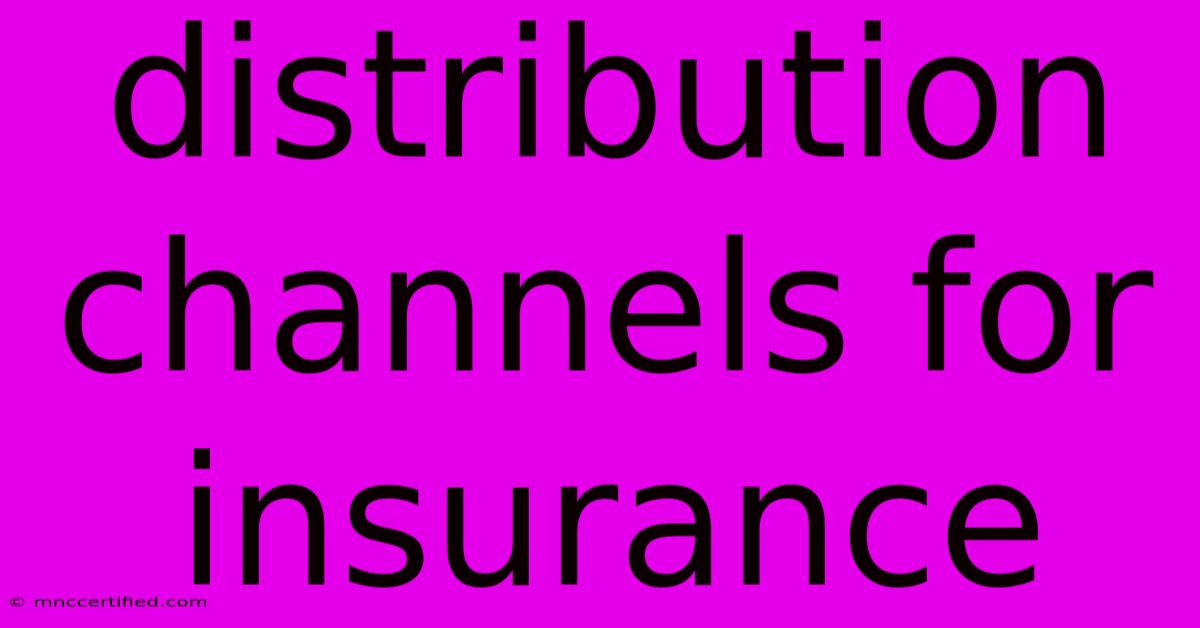Distribution Channels For Insurance

Table of Contents
Navigating the Landscape: Exploring Distribution Channels for Insurance
The insurance industry is constantly evolving, and one of the most dynamic areas of change is how insurance products are distributed. Gone are the days of relying solely on traditional channels like independent agents or captive agents. Today, insurers need to be nimble and adaptable, leveraging a diverse range of distribution channels to reach their target audience.
This article delves into the key distribution channels for insurance, exploring their strengths and weaknesses, and ultimately offering insights into how insurers can choose the right mix for their success.
Traditional Distribution Channels: The Cornerstones of Insurance
1. Independent Agents:
- What they are: Independent agents represent multiple insurance companies, offering clients a wide range of options.
- Strengths:
- Expertise: Agents provide personalized advice and support throughout the insurance process.
- Relationship-driven: They build strong relationships with clients, fostering trust and loyalty.
- Weaknesses:
- Higher commissions: Independent agents may charge higher commissions due to their independence.
- Limited reach: Their reach is often geographically restricted.
2. Captive Agents:
- What they are: Captive agents represent a single insurance company, exclusively selling their products.
- Strengths:
- Brand loyalty: They promote a specific brand, contributing to strong brand awareness.
- Consistent service: Clients receive standardized service and support.
- Weaknesses:
- Limited options: Customers have fewer choices as they are restricted to a single insurer's offerings.
- Potential bias: Agents may favor their company's products even if they are not the best fit for the client.
3. Direct Writers:
- What they are: Direct writers sell insurance directly to consumers without intermediaries.
- Strengths:
- Cost-effective: Lower overhead costs translate to potentially lower premiums.
- Convenience: Customers can purchase insurance online or over the phone, simplifying the process.
- Weaknesses:
- Lack of personal touch: Customers may miss the personalized advice and support of an agent.
- Limited customization: Policies may be less customizable compared to those offered by independent agents.
Emerging Distribution Channels: The Future of Insurance
1. Digital Platforms and Aggregators:
- What they are: Websites and apps allow customers to compare quotes from multiple insurers online.
- Strengths:
- Transparency and accessibility: Customers can access a vast range of options easily and compare prices.
- Efficiency: The entire process is streamlined, making it convenient and fast.
- Weaknesses:
- Lack of personalization: The experience may be impersonal, lacking the human touch.
- Limited support: Customers may face difficulties with complex issues or require additional guidance.
2. Fintech Companies and InsurTech:
- What they are: Innovative companies utilizing technology to revolutionize the insurance industry.
- Strengths:
- Tailored solutions: They leverage data analytics and artificial intelligence to personalize insurance offerings.
- Seamless customer experiences: They create intuitive and user-friendly digital interfaces.
- Weaknesses:
- Emerging market: The InsurTech landscape is relatively new, and some companies may lack the experience of traditional insurers.
- Data privacy concerns: The use of data raises questions about privacy and security.
3. Partnerships and Alliances:
- What they are: Insurance companies partner with other businesses to reach new audiences and offer bundled solutions.
- Strengths:
- Cross-selling opportunities: Partners can promote each other's products, expanding reach.
- Synergy: Partnerships can create complementary services, enhancing customer value.
- Weaknesses:
- Potential conflicts of interest: Partners may have competing interests, affecting customer experience.
- Complexity: Managing partnerships requires coordination and clear communication.
Choosing the Right Distribution Mix: A Strategic Approach
The optimal distribution strategy depends on a number of factors, including:
- Target audience: Who are you trying to reach, and how do they prefer to interact with insurance providers?
- Product offerings: What types of insurance products are you selling, and what level of customization do they require?
- Budget and resources: What are your financial constraints and what resources do you have available?
- Market dynamics: What are the competitive pressures and trends in your market?
Here are some key considerations for building a successful distribution strategy:
- Diversification: Don't rely on a single channel. A diverse approach helps reach a broader audience.
- Data-driven insights: Utilize analytics to track performance and optimize your channels.
- Customer-centricity: Prioritize customer needs and preferences.
- Adaptability: Stay agile and respond to changes in technology and market trends.
In conclusion, the insurance industry is at a crossroads. By embracing new technologies and adapting to changing consumer preferences, insurance companies can leverage a diverse range of distribution channels to reach new markets, enhance customer experiences, and drive growth in the years to come.

Thank you for visiting our website wich cover about Distribution Channels For Insurance. We hope the information provided has been useful to you. Feel free to contact us if you have any questions or need further assistance. See you next time and dont miss to bookmark.
Featured Posts
-
Orthodontic Narrative For Insurance
Nov 13, 2024
-
Bears Offensive Coordinator Shane Waldron Fired Amid Struggles
Nov 13, 2024
-
Costco Butter Recall Food Labeling Lessons
Nov 13, 2024
-
Black Panther 3 Cast Denzel Washington Added
Nov 13, 2024
-
Trump Picks Huckabee For Key U S Post
Nov 13, 2024